Fergusson Intermediate students are experiencing regenerative change through using the Ministry of Education’s Pūtātara resource.
With a strong identity as an Enviroschool, Fergusson Intermediate School responded quickly to the call to action issued by Pūtātara – a sustainability and global citizenship resource. In 2020 they trialled the resource with some of their classes. The results were so positive that they moved on to integrate it into a whole school plan for 2021 progressing through the three strands: Tūrangawaewae – our past and our ancestors, Kaitiakitanga – the present and taking part in regenerative change, and Whakapuāwai – looking forward to the future.
Sarah Hopkinson, leader of the team who created Pūtātara, says it’s this experience of regenerative change that our young people need in order to build the kind of future we all hope for.
Teachers explore the role schools can play in responding to climate change
During the Covid-19 pandemic in 2020, Enviroschools worked with Fergusson Intermediate to host a physically distanced climate kōrero with scientist Professor James Renwick, researcher Rachel Bolstad from the New Zealand Council for Educational Research and others interested in exploring climate change and education.
As a school they could see a need to support their students in positive, proactive responses to the environmental challenges we face and Pūtātara offered an inquiry model to achieve that.
Tūrangawaewae – Students understand where they stand
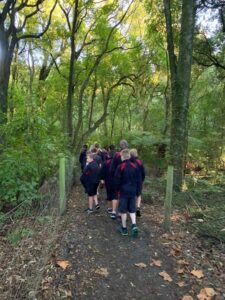
Fergusson Intermediate students in the local ngahere.
In 2021 , students explored their Tūrangawaewae – the history of their local place – through pūrākau. You can read more in this Enviroschools story.
“We…look[ed] at how Māori transformed the land, through collaboration, through whānau, through ngā atua…What did that look like? How did they record that evidence? And it was through legends, it was through storying.” Atama Cassidy – Fergusson Intermediate syndicate leader.
This gave them learnings about mauri and how the land had changed to weave into the next Pūtātara strand: Kaitiakitanga. They wanted to see if insights from the past and te ao Māori could help inform potential solutions to current issues.
Kaitiakitanga – Exploring current issues and taking action
In this strand, students formed groups to investigate the ngahere, awa and moana and identify actions they could take to regenerating their collective mauri.
“We went down to our local park and met people there who helped us plant 400 trees and plants of different species. We hope the trees will grow to be strong and be homes for lots of native birds and animals. We found out about trapping and other forms of exterminating pests in order to protect our native land. Even if you didn’t do something physical, we all researched and informed other people.” – student
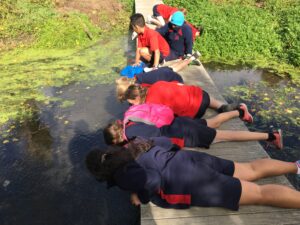
Fergusson Intermediate students investigate local stream health.
They welcomed whānau in to help plan and to find out what kaitiakitanga meant to them.
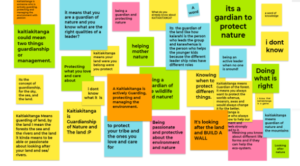
A brainstorm of students’ understandings of kaitiakitanga
“Do they nurture the taro on Sunday with their family? Are there special rituals that they do at home? …What does it look like to be a kaitiaki of our land in your culture?” Atama Cassidy – Fergusson Intermediate syndicate leader.
Whakapuāwai – projects to embrace a positive future
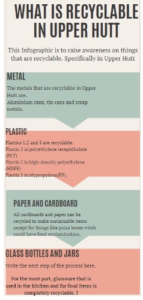
The poster Gyananjan, Try and Mo created to make it easier for their school community to recycle.
Later that year, students moved into the Whakapuāwai strand where they focused on future directions for humanity that are optimistic and they have made their voices count.
Gyananjan, Try and Mo identified that people were confused about what could be recycled.
“Many people have had good intentions and tried recycling but they are unsure of where it goes or whether it is even recyclable.” – students talk about the confusion around recycling
So they created a poster to share through school communication networks.
Avneet and Harshni collected pre-loved books to distribute to other local kura. They planned, advertised, and made cold-calls themselves to schools in the area. They made a delivery to a local school (Silverstream) who were very appreciative
Ethan, Jacob and Alex addressed food waste. They know green waste sent to landfill is an issue so they built a compost bin for their syndicate.
“I measured it out and planned it and now it’s our syndicate compost bin.”
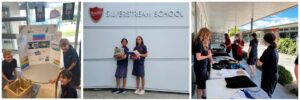
Students moved to Whakapuāwai strand where they focused on future directions for humanity.
Supported by her teachers, student Manvi Sharma took her inquiry all the way to “Fair Go!” Through studying recycling and plastic waste at school, she was shocked when she found out it was often cheaper to buy snacks like nuts pre-packaged than in the bulk bins. Manvi compared the prices from three supermarkets and found in most cases, bulk bin prices were more expensive.
With the help of Fair Go, Manvi approached the three supermarkets. Two supermarkets shared statements – and Countdown agreed to talk. Some of the issues for Countdown included the ease of handling pre-packed items, the extra work involved in looking after bulk bins and the shelf-life of food. But they did agree to re-look at their pricing, and Manvi was keen to check up on progress.
“Small steps, but positive ones.” – Manvi responding to the response from supermarkets.
Regenerative change
For Sarah Hopkinson these are examples of the best kind of learning in these times – learning that is collaborative and connected to place and community and provides an opportunity for students to understand their deep agency for change.
“Pūtātara enabled all students to connect and follow an area of interest that they were passionate about and made it really doable for teachers to integrate areas of the curriculum. We love that there is a strong focus on Te Ao Māori, and that there is a ‘take action’ component.” – teacher Robyn Stent
